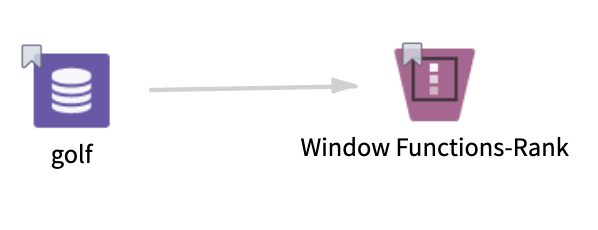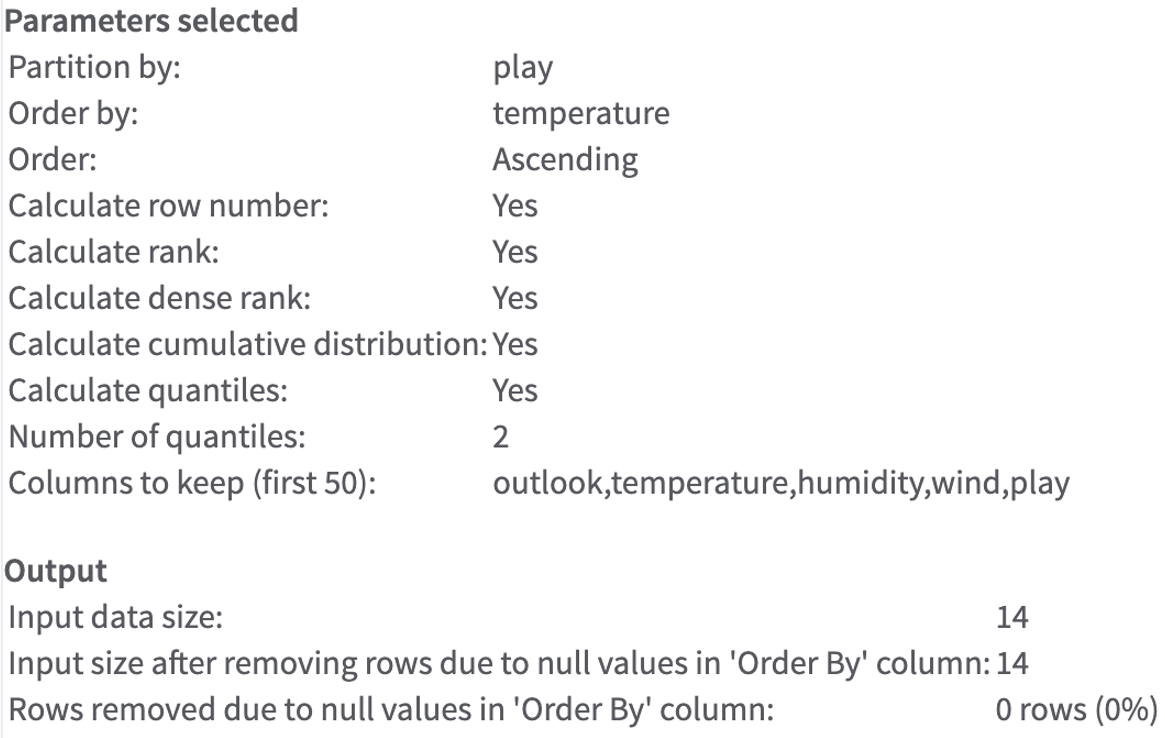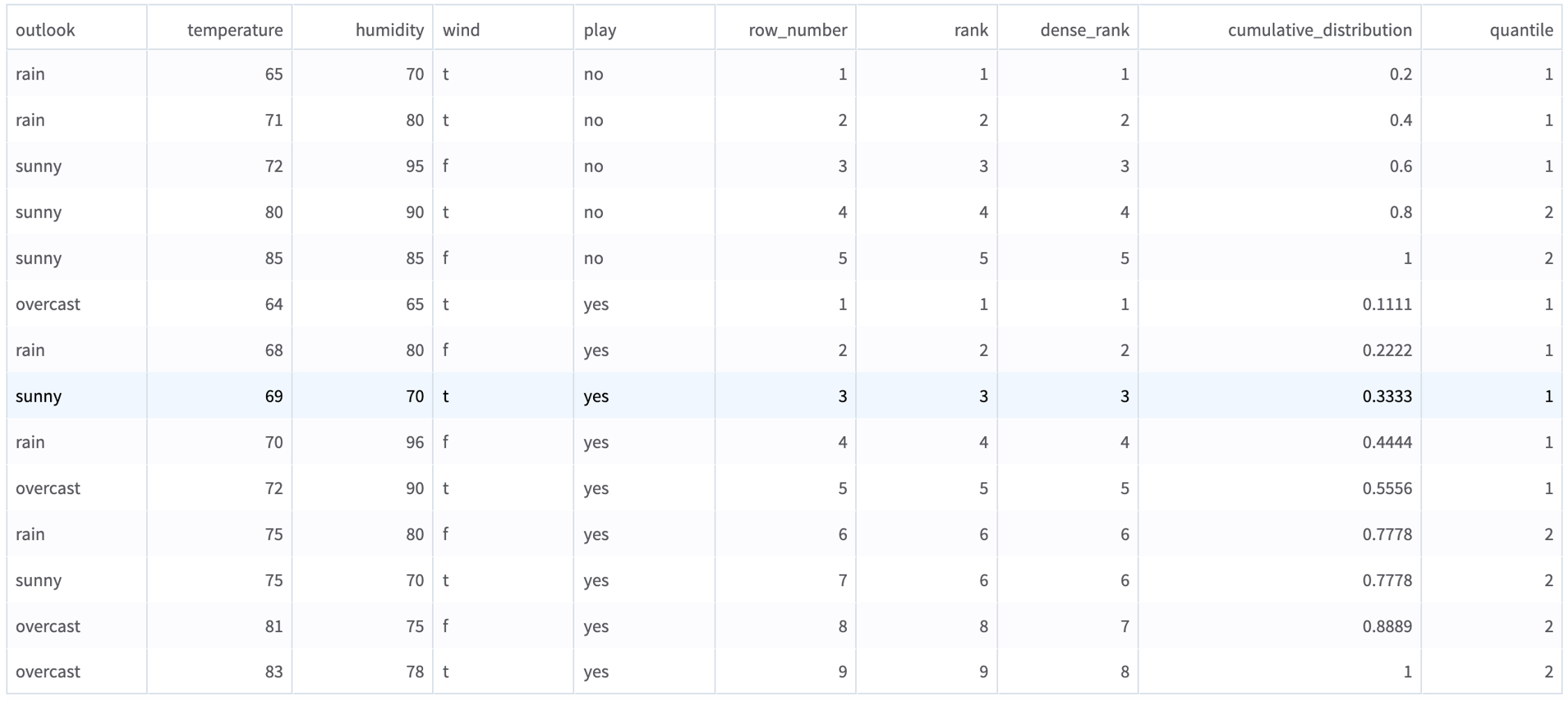Window Functions - Rank
This operator returns the rank of each row in relation to its windowed partition.

Information at a Glance
|
Parameter |
Description |
|---|---|
| Category | Transform |
| Data source type | TIBCO® Data Virtualization |
| Send output to other operators | Yes |
| Data processing tool | TIBCO® DV, Apache Spark 3.2 or later |
Algorithm
The Window Functions-Rank operator supports the
rank,
dense_rank,
cumulative distribution, and
ntile (n: number of quantiles) functions. The core concept of this operator is to compute the rank or order of each row, relative to a defined grouping or partition. An example use case is ranking transactions for individual customers, within a data set that contains unique customers. In this example, the partitioning, or grouping, is the customer ID, while the data to rank or order is the transaction value amount. Transactions within each partition or customer ID are ranked and ordered starting with 1 for the highest, and counting up.
You can use this operator to compute database-like window functions by leveraging Spark SQL. To learn more about how window functions are implemented in Spark SQL.
A window function calculates the return value for every input row of an input based on a specific group of user-defined rows called the frame. Every input row has a unique frame associated with it.
Input
An input is a single tabular data set. It must have some numeric columns where it computes numeric aggregations and includes partition by column(s) and order by columns of any type.
Null values: Before calculating any of the window functions, the operator filters any rows that contain null values in the Order By column selected. The number of rows removed due to null data is reported on the Summary tab of the visual output.
The Datetime columns must have the format specified in the input (for example, Datetime 'MM/dd/yy').
Restrictions
Wide data: This operator works quickly on long data, but performance might slow down dramatically when window functions are calculated on thousands of columns. Increasing Spark's executor memory might improve performance.
Datetime columns: Input datetime columns must have the format specified in the input (for example, Datetime 'MM/dd/yy'); otherwise, the operator returns null values for the whole column.
Configuration
The following table provides the configuration details for the Window Functions-Rank operator.
| Parameter | Description |
|---|---|
| Notes | Notes or helpful information about this operator's parameter settings. When you enter content in the Notes field, a yellow asterisk appears on the operator. |
| Partition By | Specify the column(s) by which to partition. Click Select Columns to select the required columns. |
| Order By | Specify the column by which to order each partition (all data types are supported). |
| Order | Specify the order type for the selected Order By column. |
| Calculate Row Number | Specify whether the row number function returns a sequential (and unique) number starting at 1 within an ordered partition. |
| Calculate Rank | Specify whether the rank function returns a sequential number starting at 1 within an ordered partition. |
| Calculate Dense Rank | Specify whether the dense rank function returns a sequential number starting at 1 within an ordered partition.
Note: The difference between rank and dense rank is that dense rank leaves no gaps in the ranking sequence when ties occur (for example, if three values tie for second place, all three have a dense rank of 2, and the next value has a dense rank of 3). |
| Calculate Cumulative Distribution | Specify whether the function returns the cumulative distribution of values within an ordered window partition; that is, the fraction of rows that are below the current row.
If N = total number of rows in the partition and V = number of values before (and including) x, the equation would be CUME_DIST(X)=V/N. |
| Calculate Quantiles | If
Yes, returns the n-tile group ID (from 1 to
Number of Quantiles inclusive) in an ordered window partition (equivalent to the NTILE function in SQL).
For example, if n = 4 (number of quantiles), the first quarter of the rows gets a value of 1, the second quarter gets 2, the third quarter gets 3, and the last quarter gets 4. Note: If Yes is selected, you must specify an integer value for the Number of Quantiles. |
| Number of Quantiles | If Calculate Quantiles is set to Yes, specify the number of quantiles to return for each ordered window partition. The value must be an integer > 0. |
| Columns to Keep | Specify the columns to keep in the output. Click Select Columns to select the required columns. |
| Output Schema | Specify the schema for the output table or view. |
| Output Table | Specify the table path and name where the output of the results is generated. By default, this is a unique table name based on your user ID, workflow ID, and operator. |
| Store Results | When set to Yes, the operator saves the results. If set to No, the operator does not save the results. |
Output
-
Output: A table that displays the output of a data set.
-
Summary: Displays information about the input parameters, their current settings, and a summary of the number of rows removed due to null data.
Example
The following example illustrates the Window Functions-Rank operator.

golf: This data set contains the following information:
- Multiple columns namely outlook, temperature, wind, humidity, and play.
- Multiple rows (14 rows).
Parameter Setting
The parameter settings for the golf data set are as follows:
-
Partition By: play
-
Order By: temperature
-
Order: Ascending
-
Calculate Row Number: Yes
-
Calculate Rank: Yes
-
Calculate Dense Rank: Yes
-
Calculate Cumulative Distribution: Yes
-
Calculate Quantiles: Yes
-
Number of Quantiles: 2
-
Columns to Keep: outlook, temperature, humidity, wind, play
-
Store Results: Yes
These figures displays the results for the parameter settings for the golf data set.
Summary

Output
